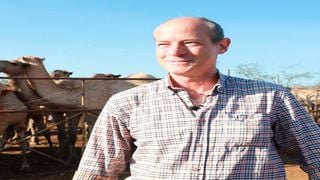
Mpala Ranch manager David Hewett. The ranch is located in Laikipia North.
| James Murimi | Nation Media GroupSeeds of Gold
Premium
Allure of camels as climate change bites
Some minutes before 7am, David Hewett and a team of five men enter a camel shed on their farm in Laikipia North, ready to milk a herd before releasing them for grazing.
They complete the task in about an hour, ending up with 40 litres from some 25 animals. The milking process had begun the previous evening when the lactating camels (cows) were separated from their calves to enable a build-up of milk. To better the milking process, the calves are released one by one from their sheds that morning.
“This helps the mothers to produce more. Each camel produces between two-and-a-half to four litres of milk but we have to leave some milk for the calves,” Hewett says.
Each day, the ranch produces 40 litres of camel milk, which is sold to White Gold Camel Dairy in Nanyuki town after every two days.
Hewett is the ranch manager at Mpala Research Centre, which carries out studies on the environment and interaction between livestock, wildlife and humans.
It is further partnering with Kenya Agriculture and Livestock Research Organisation (Kalro) to study ways of controlling and managing sub-clinical diseases in camels.
“The 134-animal herd was introduced at the research centre for human-livestock interaction. Over the last 20 years, we have done various camel studies here, with the recent one being on how to increase their milk yield and the quality of their meat for the market,” he says.
Female camels reach sexual maturity at age three and mate a year or two later. Males are sexually mature at six years. The gestation period is 15 months and it usually results in one offspring. Calves walk within a day of being born and stay with their mothers for as long as two years.
Mpala’s executive director, Dr Dino Martins, says they sell a litre of milk at Sh100.
“The demand for camel milk is so high that we cannot satisfy the market. Its economic potential is huge and has barely been tapped. The milk is highly nutritious, has low fat, lactose and sugar,” Dr Martins says.
“In future, we predict that we will get more resources from camels than we do from cattle. If the climate change continues to be more unpredictable, we will need to rely on species that can survive in a harsh environment,” he adds.
White Gold Camel Dairy chief executive director Jama Warsame says he set up the milk pasteurisation plant in August 2017 to cash in on rise in camel milk output. “We are unlocking the cash potential of camel milk to benefit people in the semi-arid communities as we endeavour to make Nanyuki a hub for camel milk,” Warsame says.
The entrepreneur injected Sh20 million savings into the camel milk business, banking on health benefits of the milk and the vagaries of climate change that are making the keeping of other livestock harder among pastoralists.
Using a pasteuriser that has a capacity of processing 50 litres, his firm processes the camel milk at 80 degrees for 40 minutes, cools it for an hour and packages it manually. Pasteurisation prolongs shelf-life to a month.
“We stepped in to help camel herders reap from their ventures as many kept the animals for subsistence. We are creating awareness on the curative elements of the camel milk.” Once pasteurised, they sell a 500ml pack of camel milk at Sh125.





